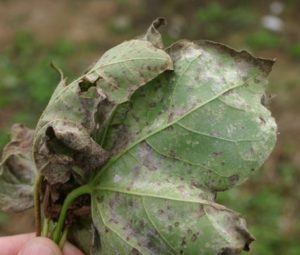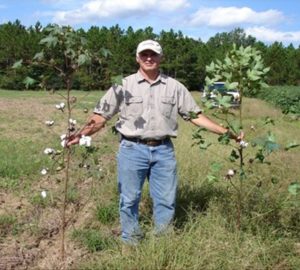
Symptoms of Areolate Mildew. Note brown necrotic lesions and powdery white sporulation on underside of leaf. (Appling County Georgia).
Caused by: Ramularia gossypii
Foliar Symptoms: Small lesions appear on leaves in the lower canopy late in the growing season. The lesions, 3-4 mm (~0.15 in) wide and restricted by a major leaf vein, are slightly chlorotic on the upper leaf surface with a white mildew growth on the lower surface. Lesions may become necrotic and resemble bacterial blight. In severe cases, premature defoliation will occur.
Diagnostic Note: No other cotton disease commonly found will have the white, powdery growth on the underside of the leaf.
Range and Yield Loss: Areolate Mildew is found in most countries where cotton is produced, but not commonly observed in the U.S. In Georgia, the disease is typically restricted to the extreme southeastern counties. This disease normally appears late in the season and usually causes little yield loss.
Use of resistant varieties is the best control strategy for Areolate Mildew. Incorporating crop residue and crop rotation will help reduce inoculum for next season. Fungicides (e.g. azoxystrobin and pyraclostrobin) were effective in managing this disease in Georgia.
